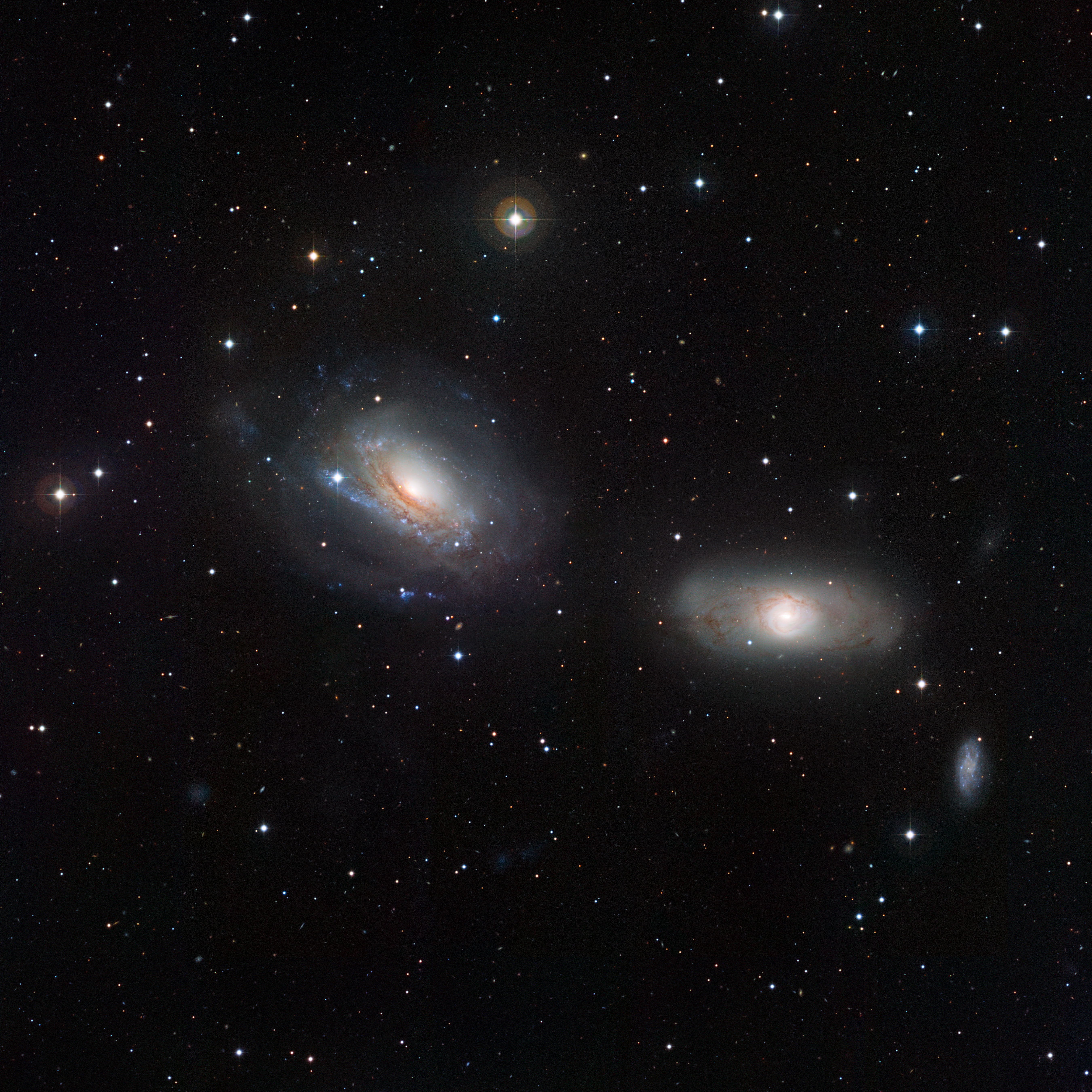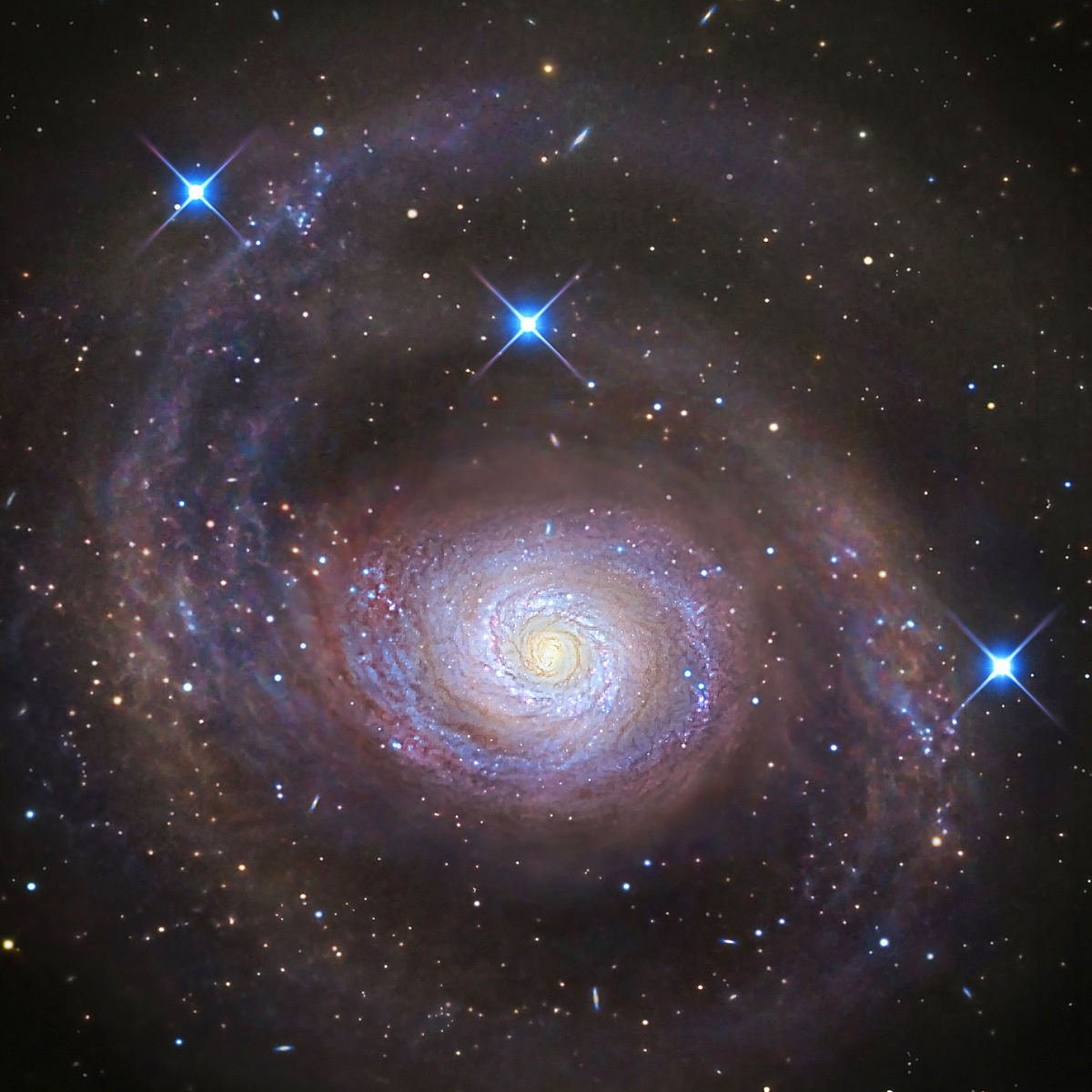|
NGC 1512
NGC 1512 is a barred spiral galaxy approximately 38 million light-years away from Earth in the constellation Horologium. The galaxy displays a double ring structure, with a (nuclear) ring around the galactic nucleus and an (inner) further out in the main disk. The galaxy hosts an extended UV disc with at least 200 clusters with recent star formation activity. NGC 1512 is a member of the Dorado Group. Gravitational interaction with NGC 1510 Gravitational tidal forces of NGC 1512 are influencing nearby dwarf lenticular galaxy NGC 1510. The two galaxies are separated by only ~5 arcmin (13.8 kpc), and are in the process of a lengthy merger which has been going on for 400 million years. At the end of this process NGC 1512 will have cannibalised its smaller companion. Interaction between these two galaxies has triggered star formation activity in the outskirts of the disc and enhanced the tidal distortion in the arms of the NGC 1512. The interaction seems to occur in the north-west ... [...More Info...] [...Related Items...] OR: [Wikipedia] [Google] [Baidu] |
Barred Spiral Galaxies
A barred spiral galaxy is a spiral galaxy with a central bar-shaped structure composed of stars. Bars are found in about two thirds of all spiral galaxies in the local universe, and generally affect both the motions of stars and interstellar gas within spiral galaxies and can affect spiral arms as well. The Milky Way Galaxy, where the Solar System is located, is classified as a barred spiral galaxy. Edwin Hubble classified spiral galaxies of this type as "SB" (spiral, barred) in his Hubble sequence and arranged them into sub-categories based on how open the arms of the spiral are. SBa types feature tightly bound arms, while SBc types are at the other extreme and have loosely bound arms. SBb-type galaxies lie in between the two. SB0 is a barred lenticular galaxy. A new type, SBm, was subsequently created to describe somewhat irregular barred spirals, such as the Magellanic Clouds, which were once classified as irregular galaxies, but have since been found to contain barred spiral ... [...More Info...] [...Related Items...] OR: [Wikipedia] [Google] [Baidu] |
New General Catalogue
The ''New General Catalogue of Nebulae and Clusters of Stars'' (abbreviated NGC) is an astronomical catalogue of deep-sky objects compiled by John Louis Emil Dreyer in 1888. The NGC contains 7,840 objects, including galaxy, galaxies, star clusters and emission nebulae. Dreyer published two supplements to the NGC in 1895 and 1908, known as the ''Index Catalogues'' (abbreviated IC), describing a further 5,386 astronomical objects. Thousands of these objects are best known by their NGC or IC numbers, which remain in widespread use. The NGC expanded and consolidated the cataloguing work of William Herschel, William and Caroline Herschel, and John Herschel's ''General Catalogue of Nebulae and Clusters of Stars''. Objects south of the Celestial sphere, celestial equator are catalogued somewhat less thoroughly, but many were included based on observation by John Herschel or James Dunlop. The NGC contained multiple errors, but attempts to eliminate them were made by the ''Revised New Ge ... [...More Info...] [...Related Items...] OR: [Wikipedia] [Google] [Baidu] |
Monthly Notices Of The Royal Astronomical Society
''Monthly Notices of the Royal Astronomical Society'' (MNRAS) is a peer-reviewed scientific journal in astronomy, astrophysics and related fields. It publishes original research in two formats: papers (of any length) and letters (limited to five pages). MNRAS publishes more articles per year than any other astronomy journal. The learned society journal has been in continuous existence since 1827 and became online only in 2020. It operates as a partnership between the Royal Astronomical Society (RAS), who select and peer-review the contents, and Oxford University Press (OUP), who publish and market the journal. Despite its name, MNRAS is no longer monthly, nor does it carry the notices of the RAS. In 2024 MNRAS became a purely gold open access journal. History The first issue of MNRAS was published on 9 February 1827 as ''Monthly Notices of the Astronomical Society of London'' and it has been in continuous publication ever since. It took its current name from the second vo ... [...More Info...] [...Related Items...] OR: [Wikipedia] [Google] [Baidu] |
NGC Objects
The ''New General Catalogue of Nebulae and Clusters of Stars'' (abbreviated NGC) is an astronomical catalogue of deep-sky objects compiled by John Louis Emil Dreyer in 1888. The NGC contains 7,840 objects, including galaxies, star clusters and emission nebulae. Dreyer published two supplements to the NGC in 1895 and 1908, known as the ''Index Catalogues'' (abbreviated IC), describing a further 5,386 astronomical objects. Thousands of these objects are best known by their NGC or IC numbers, which remain in widespread use. The NGC expanded and consolidated the cataloguing work of William and Caroline Herschel, and John Herschel's '' General Catalogue of Nebulae and Clusters of Stars''. Objects south of the celestial equator are catalogued somewhat less thoroughly, but many were included based on observation by John Herschel or James Dunlop. The NGC contained multiple errors, but attempts to eliminate them were made by the ''Revised New General Catalogue'' (RNGC) by Jack W. ... [...More Info...] [...Related Items...] OR: [Wikipedia] [Google] [Baidu] |
Interacting Galaxies
Interacting galaxies (''colliding galaxies'') are galaxies whose gravitational fields result in a disturbance of one another. Major mergers occur between galaxies with similar amounts of mass, whereas minor mergers involve galaxies with masses that vary significantly. An example of a minor interaction is a satellite galaxy disturbing the primary galaxy's spiral arms. An example of a major interaction is a galactic collision, which may lead to a galaxy merger. Satellite interaction A giant galaxy interacting with its satellites is common. A satellite's gravity could attract one of the primary's spiral arms. Alternatively, the secondary satellite can dive into the primary galaxy, as in the Sagittarius Dwarf Elliptical Galaxy diving into the Milky Way. That can possibly trigger a small amount of star formation. Such orphaned clusters of stars were sometimes referred to as "blue blobs" before they were recognized as stars. Galaxy collision Colliding galaxies are common during ... [...More Info...] [...Related Items...] OR: [Wikipedia] [Google] [Baidu] |
Messier 94
Messier 94 (also known as NGC 4736, Cat's Eye Galaxy, Crocodile Eye Galaxy, or Croc's Eye Galaxy) is a spiral galaxy in the mid-celestial hemisphere, northern constellation Canes Venatici. It was discovered by Pierre Méchain in 1781, and catalogued by Charles Messier two days later. Although some references describe M94 as a barred spiral galaxy, the "bar" structure appears to be more oval-shaped. The galaxy has two ring structures. Structure M94 is classified as having a low ionization nuclear emission region (LINER) nucleus. LINERs in general are characterized by optical astronomical spectroscopy, spectra that reveal that ionized gas is present but the gas is only weakly ionized (i.e. the atoms are missing relatively few electrons). M94 hosts a supermassive black hole (SMBH) with mass of 1.60 х 107 Mʘ as measured using stellar kinematics derived from James Webb Space Telescope, James Webb Space Telescope (JWST) data. This result is consistent with the current MBH- ... [...More Info...] [...Related Items...] OR: [Wikipedia] [Google] [Baidu] |
NGC 4314
NGC 4314 is a barred spiral galaxy approximately 53 million light-years away in the northern constellation of Coma Berenices. It is positioned around 3° to the north and slightly west of the star Gamma Comae Berenices and is visible in a small telescope. The galaxy was discovered by German-born astronomer William Herschel on March 13, 1785. It was labelled as peculiar by Allan Sandage in 1961 because of the unusual structure in the center of the bar. NGC 4314 is a member of the Coma I group of galaxies. The Galaxy morphological classification, morphological classification of this galaxy is SBa, which indicates a barred spiral galaxy A barred spiral galaxy is a spiral galaxy with a central bar-shaped structure composed of stars. Bars are found in about two thirds of all spiral galaxies in the local universe, and generally affect both the motions of stars and interstellar gas ... (SB) with very tightly wound spiral arms (a). It is inclined at an angle of 21° to the line o ... [...More Info...] [...Related Items...] OR: [Wikipedia] [Google] [Baidu] |
James Webb Space Telescope
The James Webb Space Telescope (JWST) is a space telescope designed to conduct infrared astronomy. As the largest telescope in space, it is equipped with high-resolution and high-sensitivity instruments, allowing it to view objects too old, List of the most distant astronomical objects, distant, or faint for the Hubble Space Telescope. This enables investigations across many fields of astronomy and cosmology, such as observation of the Population III star, first stars and the Galaxy formation and evolution, formation of the first galaxies, and detailed atmospheric characterization of potentially habitable exoplanets. Although the Webb's mirror diameter is 2.7 times larger than that of the Hubble Space Telescope, it produces images of comparable optical resolution, resolution because it observes in the longer-wavelength infrared spectrum. The longer the wavelength of the spectrum, the larger the information-gathering surface required (mirrors in the infrared spectrum or antenna a ... [...More Info...] [...Related Items...] OR: [Wikipedia] [Google] [Baidu] |
Hubble Space Telescope
The Hubble Space Telescope (HST or Hubble) is a space telescope that was launched into low Earth orbit in 1990 and remains in operation. It was not the Orbiting Solar Observatory, first space telescope, but it is one of the largest and most versatile, renowned as a vital research tool and as a public relations boon for astronomy. The Hubble Space Telescope is named after astronomer Edwin Hubble and is one of NASA's Great Observatories program, Great Observatories. The Space Telescope Science Institute (STScI) selects Hubble's targets and processes the resulting data, while the Goddard Space Flight Center (GSFC) controls the spacecraft. Hubble features a mirror, and its five main instruments observe in the ultraviolet, visible spectrum, visible, and near-infrared regions of the electromagnetic spectrum. Hubble's orbit outside the distortion of atmosphere of Earth, Earth's atmosphere allows it to capture extremely high-resolution images with substantially lower background lig ... [...More Info...] [...Related Items...] OR: [Wikipedia] [Google] [Baidu] |
Caltech
The California Institute of Technology (branded as Caltech) is a private university, private research university in Pasadena, California, United States. The university is responsible for many modern scientific advancements and is among a small group of Institute of Technology (United States), institutes of technology in the United States that are devoted to the instruction of pure and applied sciences. The institution was founded as a preparatory and vocational school by Amos G. Throop in 1891 and began attracting influential scientists such as George Ellery Hale, Arthur Amos Noyes, and Robert Andrews Millikan in the early 20th century. The vocational and preparatory schools were disbanded and spun off in 1910, and the college assumed its present name in 1920. In 1934, Caltech was elected to the Association of American Universities, and the antecedents of NASA's Jet Propulsion Laboratory, which Caltech continues to manage and operate, were established between 1936 and 1943 under ... [...More Info...] [...Related Items...] OR: [Wikipedia] [Google] [Baidu] |
NASA
The National Aeronautics and Space Administration (NASA ) is an independent agencies of the United States government, independent agency of the federal government of the United States, US federal government responsible for the United States's civil list of government space agencies, space program, aeronautics research and outer space, space research. National Aeronautics and Space Act, Established in 1958, it succeeded the National Advisory Committee for Aeronautics (NACA) to give the American space development effort a distinct civilian orientation, emphasizing peaceful applications in space science. It has since led most of America's space exploration programs, including Project Mercury, Project Gemini, the 1968–1972 Apollo program missions, the Skylab space station, and the Space Shuttle. Currently, NASA supports the International Space Station (ISS) along with the Commercial Crew Program and oversees the development of the Orion (spacecraft), Orion spacecraft and the Sp ... [...More Info...] [...Related Items...] OR: [Wikipedia] [Google] [Baidu] |





